Foundations Of Algebra
Writing Algebraic Equations

 Problem: Jeanne has $17 in her piggy bank. How much money does she need to buy a game that costs $68?
Solution: Let x represent the amount of money Jeanne needs. Then the following equation can represent this problem:
17 + x = 68
We can subtract 17 from both sides of the equation to find the value of x.
68 - 17 = x
Answer: x = 51, so Jeanne needs $51 to buy the game.
In the problem above, x is a variable. The symbols 17 + x = 68 form an algebraic equation. Let's look at some examples of writing algebraic equations.
Example 1: Write each sentence as an algebraic equation.
Problem: Jeanne has $17 in her piggy bank. How much money does she need to buy a game that costs $68?
Solution: Let x represent the amount of money Jeanne needs. Then the following equation can represent this problem:
17 + x = 68
We can subtract 17 from both sides of the equation to find the value of x.
68 - 17 = x
Answer: x = 51, so Jeanne needs $51 to buy the game.
In the problem above, x is a variable. The symbols 17 + x = 68 form an algebraic equation. Let's look at some examples of writing algebraic equations.
Example 1: Write each sentence as an algebraic equation.
Sentence Algebraic Equation A number increased by nine is fifteen. y + 9 = 15 Twice a number is eighteen. 2n = 18 Four less than a number is twenty. x - 4 = 20 A number divided by six is eight. 
Example 2: Write each sentence as an algebraic equation.
Sentence Algebraic Equation Twice a number, decreased by twenty-nine, is seven. 2t - 29 = 7 Thirty-two is twice a number increased by eight. 32 = 2a + 8 The quotient of fifty and five more than a number is ten. 
Twelve is sixteen less than four times a number. 12 = 4x - 16
Example 3: Write each sentence as an algebraic equation.
Sentence Algebraic Equation Eleni is x years old. In thirteen years she will be twenty-four years old. x + 13 = 24 Each piece of candy costs 25 cents. The price of h pieces of candy is $2.00. 25h = 200 or .25h = 2.00 Suzanne made a withdrawal of d dollars from her savings account. Her old balance was $350, and her new balance is $280. 350 - d = 280 A large pizza pie with 15 slices is shared among p students so that each student's share is 3 slices. 
Summary: An algebraic equation is an equation that includes one or more variables. In this lesson, we learned how to write a sentence as an algebraic equation.
https://www.mathgoodies.com/lessons/vol7/equations

 Problem: Jeanne has $17 in her piggy bank. How much money does she need to buy a game that costs $68?
Problem: Jeanne has $17 in her piggy bank. How much money does she need to buy a game that costs $68?
Solution: Let x represent the amount of money Jeanne needs. Then the following equation can represent this problem:
17 + x = 68
We can subtract 17 from both sides of the equation to find the value of x.
68 - 17 = x
Answer: x = 51, so Jeanne needs $51 to buy the game.
In the problem above, x is a variable. The symbols 17 + x = 68 form an algebraic equation. Let's look at some examples of writing algebraic equations.
Example 1: Write each sentence as an algebraic equation.
| Sentence | Algebraic Equation |
| A number increased by nine is fifteen. | y + 9 = 15 |
| Twice a number is eighteen. | 2n = 18 |
| Four less than a number is twenty. | x - 4 = 20 |
| A number divided by six is eight. |
Example 2: Write each sentence as an algebraic equation.
| Sentence | Algebraic Equation |
| Twice a number, decreased by twenty-nine, is seven. | 2t - 29 = 7 |
| Thirty-two is twice a number increased by eight. | 32 = 2a + 8 |
| The quotient of fifty and five more than a number is ten. | |
| Twelve is sixteen less than four times a number. | 12 = 4x - 16 |
Example 3: Write each sentence as an algebraic equation.
| Sentence | Algebraic Equation |
| Eleni is x years old. In thirteen years she will be twenty-four years old. | x + 13 = 24 |
| Each piece of candy costs 25 cents. The price of h pieces of candy is $2.00. | 25h = 200 or |
| .25h = 2.00 | |
| Suzanne made a withdrawal of d dollars from her savings account. Her old balance was $350, and her new balance is $280. | 350 - d = 280 |
| A large pizza pie with 15 slices is shared among p students so that each student's share is 3 slices. |
Summary: An algebraic equation is an equation that includes one or more variables. In this lesson, we learned how to write a sentence as an algebraic equation.
https://www.mathgoodies.com/lessons/vol7/equations
Anatomy
Reflecting on mirror neurons
Mirror neurons are cells that fire during both the execution and observation of a specific action. They have been linked to many behaviours and abilities, from empathy to learning by imitation, as well as implicated in conditions such as autism. Mirror neurons were discovered in monkeys, but it's still not clear whether they also exist in the human brain.
Mirror neurons were identified in the brains of macaque monkeys by a team of Italian researchers during experiments performed in the 1990s. The researchers, who were studying how the brain controls hand and mouth movements, implanted microelectrodes into the monkeys' brains in order to monitor the activity of single cells while the animals reached for pieces of food and put them into their mouths. These experiments revealed that the activity of certain cells increased when the monkeys performed this action.
Mirror neurons were identified in the brains of macaque monkeys by a team of Italian researchers during experiments performed in the 1990s. The researchers, who were studying how the brain controls hand and mouth movements, implanted microelectrodes into the monkeys' brains in order to monitor the activity of single cells while the animals reached for pieces of food and put them into their mouths. These experiments revealed that the activity of certain cells increased when the monkeys performed this action.
The cells in question are located in the premotor cortex, a part of the brain involved in planning and executing movements, so the finding was not in itself particularly surprising. By chance, however, the researchers discovered that a few of the same cells also fired weakly when the animals merely observed the researchers putting food into their own mouths, and fired more strongly when they saw other monkeys performing the same action. Subsequently, the same team of researchers identified mirror neurons in several other regions of the monkey brain. They also located cells that fire when monkeys observe an action as well as when they hear the sound related to it.
But what does it all mean? The precise role of the mirror neuron system in monkeys is still not known, though the researchers who discovered them believe that they perform two functions. First, that mirror neurons are involved in understanding the actions of others – observing an action triggers the mirror neuron system to generate a motor representation of it. This corresponds to the activity produced by the action itself: in other words, the mirror neuron system transforms the visual information into knowledge of the intention of the others' actions. The second proposed function is imitation – or learning to perform an action by observing others.
https://www.theguardian.com/science/neurophilosophy/2013/aug/23/mirror-neurons
Geometry
Rules for Chords, Secants,
and Tangents in CirclesMathBitsNotebook.com Topical Outline | Geometry Outline | MathBits' Teacher Resources Terms of Use Contact Person: Donna Roberts |
Theorems:
|
If two chords intersect in a circle, the product of the lengths of the segments of one chord equal the product of the segments of the other.
| |||
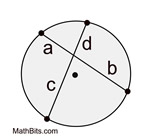 |
Formula: a • b = c • d | ||
|
If two secant segments are drawn to a circle from the same external point, the product of the length of one secant segment and its external part is equal to the product of the length of the other secant segment and its external part.
| |||
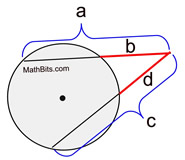 |
Formula: a • b = c • d | ||
|
If a secant segment and tangent segment are drawn to a circle from the same external point, the length of the tangent segment is the geometric mean between the length of the secant segment and the length of the external part of the secant segment.
| |||
Alternate Wording:
|
... the product of the length of the secant segment and its external part equals the square of the length of the tangent segment.
| ||
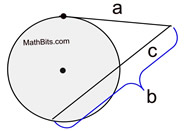 |
Formula:  | ||
|
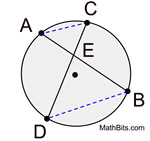

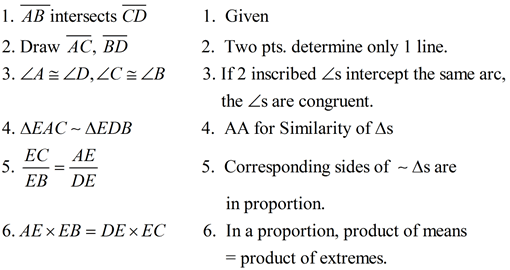
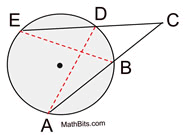


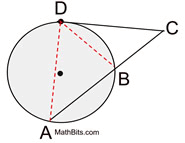

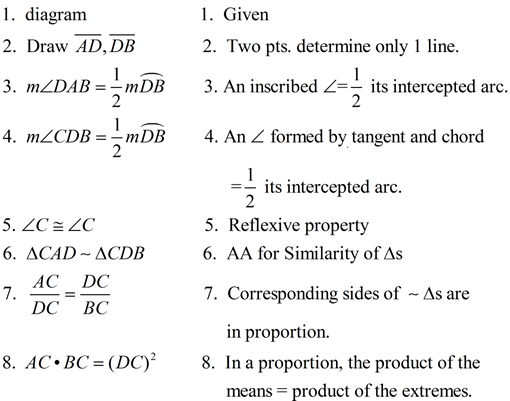
No comments:
Post a Comment